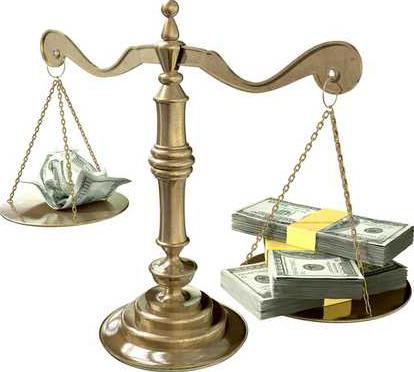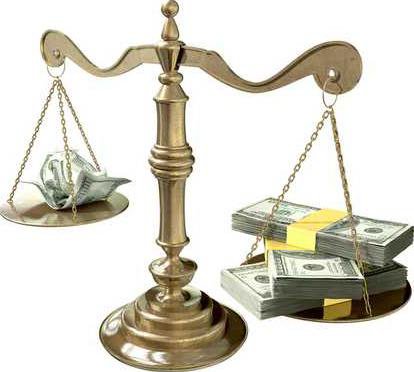The economic middle class has been a majority in the United States for the past four decades. No longer, according to Pew Research Center, which released a report last week announcing that the combination of the upper and lower classes now comprises more than 50 percent of the population.
The rubric for defining the middle-class based on a percentage of the countrys median income identifies an individual making $24,000 and $72,000 as middle class. For a family of five, the household income is $54,000 to $162,000.
While the percentage of people with low income has increased, the upper-income tier has grown faster. Pew notes that this, in a way, can be an indication of economic progress. Since 1971 when 61 percent of the population was middle class the upper class has grown 50 percent, whereas the lower class has grown only 16 percent.
Pews release comes on the heels of another study by the Institute for Policy Studies that said the richest 20 Americans now control as much wealth as half of the entire population.
To combat this inequality, the IPS stressed the elimination of tax havens and loopholes and supporting the Responsible Estate Tax Act, which aims to make the estate tax more progressive by adding graduated rates on larger estates.
Wealthy individuals are moving quickly to shift wealth into offshore tax havens and bury it in private trusts, avoiding accountability and taxation every step of the way. This hidden wealth now totals in the trillions, IPSs authors said.
Earlier this year, Gabriel Zucman an assistant professor of economics at UC-Berkeley published "The Hidden Wealth of Nations" that said the tax evasion identified by IPS is the greatest contributor to wealth inequality in the world.
Zucman said approximately 8 percent of the worlds financial assets are hidden in such a way to avoid taxation, which places the tax burden on less wealthy people.
Zucman told New York magazine that the populace is naive to the consequences of this.
"They think, 'We know companies avoid taxes, but thats good for American businesses,'" Zucman said. "They don't understand. The effective tax rate on wealth and capital is a key determinant of wealth inequality in the long run."
According to The Wall Street Journal, the inequality discussion typically focuses on the gap between the rich and the poor, but disparity between the old and the young is another important factor in the equation.
Recent research by White House economists, the WSJ reported, shows that the gap is much more pronounced that previously assumed. The average net worth of a 62-year-old American is $910,000 for a 40-year-old, its $308,000 and only $93,000 for the average 30-year-old.
The Journal noted that age gap could lead to concentration of wealth among a smaller group as money gets passed down as inheritance. The average 80-year-old who's already outlasted U.S. life expectancy has an average net worth of $549,000.
The rubric for defining the middle-class based on a percentage of the countrys median income identifies an individual making $24,000 and $72,000 as middle class. For a family of five, the household income is $54,000 to $162,000.
While the percentage of people with low income has increased, the upper-income tier has grown faster. Pew notes that this, in a way, can be an indication of economic progress. Since 1971 when 61 percent of the population was middle class the upper class has grown 50 percent, whereas the lower class has grown only 16 percent.
Pews release comes on the heels of another study by the Institute for Policy Studies that said the richest 20 Americans now control as much wealth as half of the entire population.
To combat this inequality, the IPS stressed the elimination of tax havens and loopholes and supporting the Responsible Estate Tax Act, which aims to make the estate tax more progressive by adding graduated rates on larger estates.
Wealthy individuals are moving quickly to shift wealth into offshore tax havens and bury it in private trusts, avoiding accountability and taxation every step of the way. This hidden wealth now totals in the trillions, IPSs authors said.
Earlier this year, Gabriel Zucman an assistant professor of economics at UC-Berkeley published "The Hidden Wealth of Nations" that said the tax evasion identified by IPS is the greatest contributor to wealth inequality in the world.
Zucman said approximately 8 percent of the worlds financial assets are hidden in such a way to avoid taxation, which places the tax burden on less wealthy people.
Zucman told New York magazine that the populace is naive to the consequences of this.
"They think, 'We know companies avoid taxes, but thats good for American businesses,'" Zucman said. "They don't understand. The effective tax rate on wealth and capital is a key determinant of wealth inequality in the long run."
According to The Wall Street Journal, the inequality discussion typically focuses on the gap between the rich and the poor, but disparity between the old and the young is another important factor in the equation.
Recent research by White House economists, the WSJ reported, shows that the gap is much more pronounced that previously assumed. The average net worth of a 62-year-old American is $910,000 for a 40-year-old, its $308,000 and only $93,000 for the average 30-year-old.
The Journal noted that age gap could lead to concentration of wealth among a smaller group as money gets passed down as inheritance. The average 80-year-old who's already outlasted U.S. life expectancy has an average net worth of $549,000.

